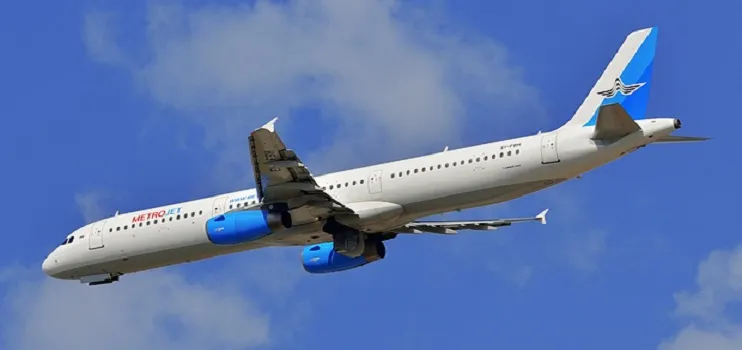
Did a bomb bring down Metrojet A321?
Nov 04, 2015

The crash of Metrojet A321 over the Sinai Peninsula in October 2015 has been a subject of significant investigation and speculation. Initial reports suggested that a bomb might have caused the aircraft's disintegration shortly after takeoff from Sharm El Sheikh, leading to the tragic loss of all 224 passengers and crew on board. Subsequent analyses by various intelligence agencies indicated that an explosive device was likely placed on the plane, potentially linked to terrorist groups operating in the region. This incident raised concerns about airport security and prompted international discussions on aviation safety measures in conflict zones.
The tragic crash of Metrojet A321 over the Sinai Peninsula in 2015 raised numerous questions and theories regarding the cause of the disaster. Investigations into the incident revealed several possibilities, with one of the most discussed theories being the potential involvement of a bomb. This article delves into the details surrounding the crash, the investigations that followed, and the implications of the findings on aviation security.
Background of the Metrojet A321 Crash
On October 31, 2015, Metrojet Flight 9268, an Airbus A321, was en route from Sharm El Sheikh, Egypt, to St. Petersburg, Russia, when it suddenly lost altitude and crashed shortly after takeoff, killing all 224 passengers and crew on board. The A321 was a popular aircraft, known for its safety and reliability, which made this incident shocking for the aviation community.
Investigative Findings
Following the crash, various international agencies, including the Russian Federal Air Transport Agency and the Egyptian government, launched thorough investigations. Multiple theories were considered, but one stood out due to circumstantial evidence and intelligence reports: the possibility of an explosive device being planted on the aircraft.
Evidence Supporting the Bomb Theory
In November 2015, Russia's Federal Security Service (FSB) announced that it had found traces of explosives on the wreckage of the Metrojet A321. This claim was supported by satellite imagery and analysis of the flight path, which indicated an abrupt loss of altitude consistent with an explosion. The following chart summarizes key findings related to the investigation:
| Finding | Details |
|---|---|
| Explosive Residue | Traces of TNT and other compounds found on wreckage |
| Flight Path Analysis | Sudden loss of altitude consistent with an in-flight explosion |
| Intelligence Reports | Indications of a possible terrorist plot against Russian tourists |
| Security Measures | Increased security protocols in Egyptian airports following the incident |
International Response and Security Implications
The implications of the findings were far-reaching. As a result of the investigation, many nations, including the UK and the US, imposed travel bans and restrictions on flights to and from Egypt. The incident prompted a reevaluation of security measures at airports around the globe, particularly in regions known for terrorism threats.
Impact on Aviation Security
The Metrojet A321 disaster highlighted vulnerabilities in aviation security, particularly regarding the screening of passengers and luggage. In response, airports worldwide began to adopt stricter security protocols, including enhanced screening techniques and increased surveillance. Additionally, there was a push for greater international cooperation in sharing intelligence related to potential threats.
Conclusion
In conclusion, while the investigation into the crash of Metrojet A321 has pointed towards the possibility of a bomb being the cause, the complexities surrounding the incident continue to spark discussions about aviation safety and security. The tragic loss of 224 lives serves as a stark reminder of the ongoing challenges faced by the aviation industry in ensuring passenger safety. Key learnings from this incident have led to improved measures designed to prevent similar tragedies in the future.
As we reflect on the events surrounding the Metrojet A321 crash, it is crucial to continue advocating for enhanced security protocols and international cooperation to safeguard air travel. The aviation community must remain vigilant, understanding that the safety of passengers is paramount.
Related Articles

Explore Thailand: The Best Islands to Visit for Paradise, Adventure, and Relaxation

The Ultimate Guide to the Best Islands in Thailand for Your Next Getaway

Do babies need passports? How to get a passport for a newborn

How to get a U.S. passport fast: here’s how to expedite the process

What is Mobile Passport Control: 5 reasons why you should use it

SENTRI vs. Global Entry: A detailed guide

Do you need a passport to go to the Bahamas? Let’s find out

Do you need a passport to go to Mexico? A detailed guide

Do you need a passport to go to Canada? We got the answer

Do You Need a Passport for a Cruise: An Essential Travel Guide

Booster Seat Requirements: All the Rules to Follow in Your Rental Car

What Are the World’s Most Powerful Passports, and How Does Yours Rank?

How to Take a Passport Photo at Home: A Helpful Guide

You've got to have heart! Southwest's new livery

Your opinion: Should water be free on low cost carriers?

Young women bolder than guys as solo travellers
